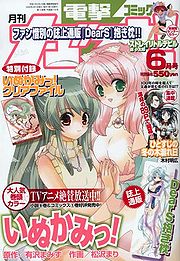
Dengeki Comic Gao!
Encyclopedia

Japan
Japan is an island nation in East Asia. Located in the Pacific Ocean, it lies to the east of the Sea of Japan, China, North Korea, South Korea and Russia, stretching from the Sea of Okhotsk in the north to the East China Sea and Taiwan in the south...
ese shōnen
Shonen
The term refers to manga marketed to a male audience aged roughly 10 and up. The Kanji characters literally mean "few" and "year", respectively, where the characters generally mean "comic"...
manga magazine that primarily contained manga
Manga
Manga is the Japanese word for "comics" and consists of comics and print cartoons . In the West, the term "manga" has been appropriated to refer specifically to comics created in Japan, or by Japanese authors, in the Japanese language and conforming to the style developed in Japan in the late 19th...
and information about series featuring bishōjo
Bishojo
is a Japanese term used to refer to young and pretty girls, usually below university age. Bishōjo is not listed as a word in the prominent Japanese dictionary Kōjien...
characters. It was published from December 1992 to February 2008 by MediaWorks
MediaWorks (publisher)
was a Japanese publishing company in the Kadokawa Group known for their brand magazines and book labels. These included such well-known magazines as Dengeki Daioh, and Dengeki G's Magazine, along with MediaWorks' main light novel publishing imprint Dengeki Bunko. The company was merged with ASCII...
. The Gao in the magazine's title is a childish form of the sound Grr. Many manga serialized in Dengeki Comic Gao! were adapted from light novel
Light novel
A is a style of Japanese novel primarily targeting junior high and high school students . The term "light novel" is a wasei-eigo, or a Japanese term formed from words in the English language. Light novels are often called or for short...
s published under MediaWorks' Dengeki Bunko
Dengeki Bunko
is a publishing imprint affiliated with the Japanese publishing company ASCII Media Works . It was established in June 1993 with the publication of Hyōryū Densetsu Crystania volume one, and is a light novel imprint aimed at a male audience...
label. The magazine was sold every month on the twenty-seventh.
When Dengeki Comic Gao! was first published, many of the manga that ran in the magazine had transferred from Kadokawa Shoten
Kadokawa Shoten
is a well-known Japanese publishing company based in Tokyo, Japan. Kadokawa has published both manga novels and magazines, such as Newtype magazine...
's Comic Comp magazine, though many of the titles were slightly altered. This caused the readers of Comic Comp to become interested in Dengeki Comic Gao! and in October 1994, Comic Comp ceased publication. Gradually, it became apparent that MediaWorks' similar manga magazine Dengeki Daioh
Dengeki Daioh
is a Japanese shōnen manga magazine published by ASCII Media Works under the Dengeki brand. Many manga serialized in Dengeki Daioh were later published in tankōbon volumes under ASCII Media Works' Dengeki Comics imprint. The magazine is sold every month on the 27th...
was much more popular, and in response, Dengeki Comic Gao! was reformatted starting with the February 2007 issue on December 27, 2006. This was also when the Gao as printed on the magazine cover was changed from being spelled in katakana
Katakana
is a Japanese syllabary, one component of the Japanese writing system along with hiragana, kanji, and in some cases the Latin alphabet . The word katakana means "fragmentary kana", as the katakana scripts are derived from components of more complex kanji. Each kana represents one mora...
to being spelled in English
English language
English is a West Germanic language that arose in the Anglo-Saxon kingdoms of England and spread into what was to become south-east Scotland under the influence of the Anglian medieval kingdom of Northumbria...
stylized as gao. On December 9, 2006, the first issue of a special edition version of Dengeki Comic Gao! called Comic Sylph was published, and is sold quarterly; starting with volume six, Comic Sylph became a special edition version of Dengeki Daioh
Dengeki Daioh
is a Japanese shōnen manga magazine published by ASCII Media Works under the Dengeki brand. Many manga serialized in Dengeki Daioh were later published in tankōbon volumes under ASCII Media Works' Dengeki Comics imprint. The magazine is sold every month on the 27th...
on March 21, 2008.
The last issue, nicknamed , was sold on February 27, 2008 with most of the currently serialized titles reaching their final chapters, while some others will continue publication in MediaWorks
MediaWorks (publisher)
was a Japanese publishing company in the Kadokawa Group known for their brand magazines and book labels. These included such well-known magazines as Dengeki Daioh, and Dengeki G's Magazine, along with MediaWorks' main light novel publishing imprint Dengeki Bunko. The company was merged with ASCII...
's similarly themed magazine Dengeki Daioh
Dengeki Daioh
is a Japanese shōnen manga magazine published by ASCII Media Works under the Dengeki brand. Many manga serialized in Dengeki Daioh were later published in tankōbon volumes under ASCII Media Works' Dengeki Comics imprint. The magazine is sold every month on the 27th...
.
List of serialized titles
|
Nanatsuiro Drops is a Japanese visual novel developed by UNiSONSHIFT and released on April 21, 2006. The first version, available on the PC, contains adult-only content. A version ported to the PlayStation 2 by MediaWorks was released without this content on September 20, 2007... Oku-sama wa Maho Shojo: Bewitched Agnes is a magical girl anime comedy. It was produced by Media Factory, J.C. Staff, and Amber Film Works, and was broadcast on several television channels in Japan between July and September 2005... Omishi Magical Theater: Risky Safety is an anime created by Rei Omishi, and it follows the journeys of an apprentice shinigami, or death god, named Risky and an apprentice angel named Safety who have been trapped in the same body... Shadows of Spawn Shadows of Spawn is a licensed Japanese manga adaptation of Todd McFarlane's American Spawn comic series, written and drawn by Juzo Tokoro. It was originally printed in Japan from 1998 to 1999 in the monthly manga magazine Dengeki Comic Gao!, published by MediaWorks... Sorcerer Hunters is a 13-volume manga series, written by Satoru Akahori and illustrated by Rei Omishi. Akahori and Omishi also published Sorcerer Hunters Special, a one-volume story set sometime after the series' conclusion.... Speed Grapher is a 2005 anime series created by Gonzo. The series ran for 24 episodes from April to October 2005 on TV Asahi. In 2006, it was licensed for release in North America by Funimation Entertainment and aired on the Independent Film Channel between March 7 and August 15, 2008... Stray Little Devil is a Japanese manga series written and illustrated by Kotaro Morio. The manga was originally serialized in Dengeki Comic Gao!, and was later published into five bound volumes by MediaWorks from January 2005 to March 2007. DrMaster Publications Inc. licensed the manga series for English-language... Those Who Hunt Elves is a manga series and an anime television series by Yu Yagami, released in North America on VHS and DVD by ADV Films. The plot revolves around three travellers, the eponymous "Elf Hunters", and the elven sorceress Mistress Celcia.-Plot:... Tokimeki Memorial Only Love is a Japanese anime series produced by Konami Digital Entertainment Co., Ltd., based on Konami's popular Tokimeki Memorial dating simulation series, specifically Tokimeki Memorial Online. It premiered October 3, 2006 across Japan on TV Tokyo. The anime series ended its run on March 27, 2007 with 25... Toradora! is a Japanese light novel series by Yuyuko Takemiya, with illustrations by Yasu. The series includes ten novels released between March 10, 2006 and March 10, 2009, published by ASCII Media Works under their Dengeki Bunko imprint. Three volumes of a spin-off light novel series was also created,... Ultimate Girls is a Japanese fanservice UHF anime series from the production company m.o.e. which parodies the genres of tokusatsu, kaiju, and superheroes; mainly themes from the Ultra Series and Kyodai Hero sub-genre... Venus Versus Virus is a Japanese manga series created by Atsushi Suzumi which was first serialized on June 27, 2005 in MediaWorks' shōnen manga magazine Dengeki Comic Gao!... Wagaya no Oinari-sama. is a Japanese light novel series by Jin Shibamura, with illustrations by Eizō Hōden. The first novel was released on February 10, 2004, and as of October 10, 2007, seven volumes have been published by ASCII Media Works under their Dengeki Bunko imprint... Watashitachi no Tamura-kun is a two-volume Japanese light novel series by Yuyuko Takemiya, with illustrations by Yasu. The first volume was released on June 10, 2005, and the second followed on September 10, 2005, both published by MediaWorks under their Dengeki Bunko label... |

